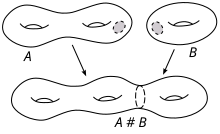Intersection forms on 4-manifolds
Let $X$ denote a connected oriented, closed manifold of dimension 4 with trivial fundamental group. The homology groups $H_k(X;\mathbb Z)$ of $X$ are trivial for $k\notin \{0,2,4\}$. For $k\in \{0,4\}$, these homology groups are canonically identified with $\mathbb Z$. The only remaining homology group carries a symmetric bilinear form $$H_2(X;\mathbb Z)\times H_2(X;\mathbb Z)\to \mathbb Z,$$ which associates to classes represented by transversely embedded oriented surfaces the oriented number of intersection points. Because of Poincaré duality, this bilinear form is unimodular.
This raises obvious questions.
- Which intersection forms are realized by 4-manifolds?
- Are 4-manifolds completely determined by their intersection forms?
The following theorem gives a hint that answers to these questions can not expected to be straightforward.
Theorem (Rokhlin 1952). If a smooth compact 4-manifold has a spin structure, then the signature of its intersection form is divisible by 16.
The spin condition will be dwelled upon lateron. At this stage it suffices to note that a simply connected manifold is spin iff its intersection form is even.
Let's consider examples.
- The four dimensional sphere $S^4$ has $H_2(S^4;\mathbb Z)=0$.
- The complex plane $\mathbb CP^2$ has $H_2(\mathbb CP^2;\mathbb Z)\cong \mathbb Z$. A projective line $L\subset \mathbb CP^2$ represents a generator. Any two complex lines intersect in exactly one point. Thus $Q(\mathbb CP^2)=\langle 1\rangle$.
- The product $S^2\times S^2$ of two-spheres has $$H_2(S^2\times S^2;\mathbb Z)=\mathbb Z [pt \times S^2]\oplus \mathbb Z[S^2\times pt].$$ The generators are represented by fibers of the projections onto the factors. As fibers of the same projection don't intersect and fibers of different projections intersect in exactly one point, the intersection form is represented by the hyperbolic plane $H$.
- The K3-surface can be constructed as a quartic in $\mathbb CP^3$, for example $$K3=\left\{(x_0:x_1:x_2:x_3)\in \mathbb CP^3\,|\, x_0^4+x_1^4+x_2^4+x_4^4=0\right\}.$$Using characteristic class computations and the fact that hypersurfaces in $\mathbb CP^3$ are simply connected, one can easily deduce that the intersection form on a K3-surface is of the form $$Q(K3)=2\cdot(-E_8)\perp 3\cdot H.$$
Using these manifolds as building blocks, we can realize other intersection forms:
- Changing the orientation of the manifold replaces the intersection form by its negative.
- The intersection form of a connected sum $A\# B$ of manifolds is the orthogonal sum of the intersection forms of the respective summands. $$Q\left(A\# B\right)=Q(A)\perp Q(B)$$

As a consequence,
- all diagonal odd forms can be realized by connected sums of the complex projective plane and its conjugate.
- an even quadratic form can be realized by connected sums of copies of $S^2\times S^2$ of K3's and its conjugate, if the signature is divisible by 16 and, furthermore, the inequality $$8r\ge 11|\sigma|$$ between rank and signature is satisfied.
Moreover, there is a feature with 4-manifolds which very much resembles the classification of indefinite quadratic forms:
Theorem (Wall, 1964) If simply-connected, smooth 4-manifolds $A$ and $B$ have isomorphic intersection forms, then for some $k$, $A\,\#\,k(S^2\times S^2)$ and $B\,\#\,k(S^2\times S^2)$ are diffeomorphic.
This in broad strokes summarizes what was known in 1980.
Enter Michael Freedman and Simon Donaldson.
